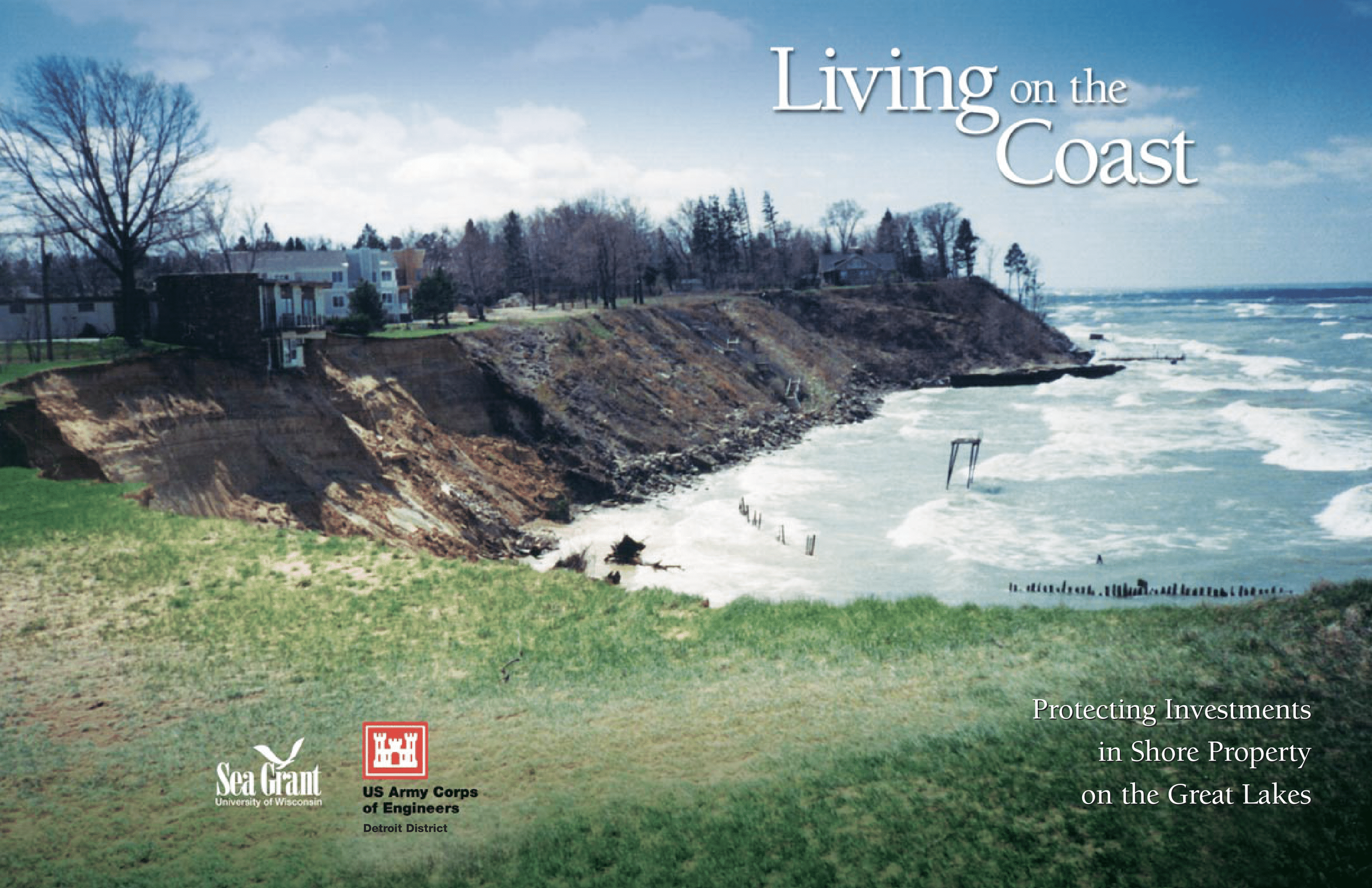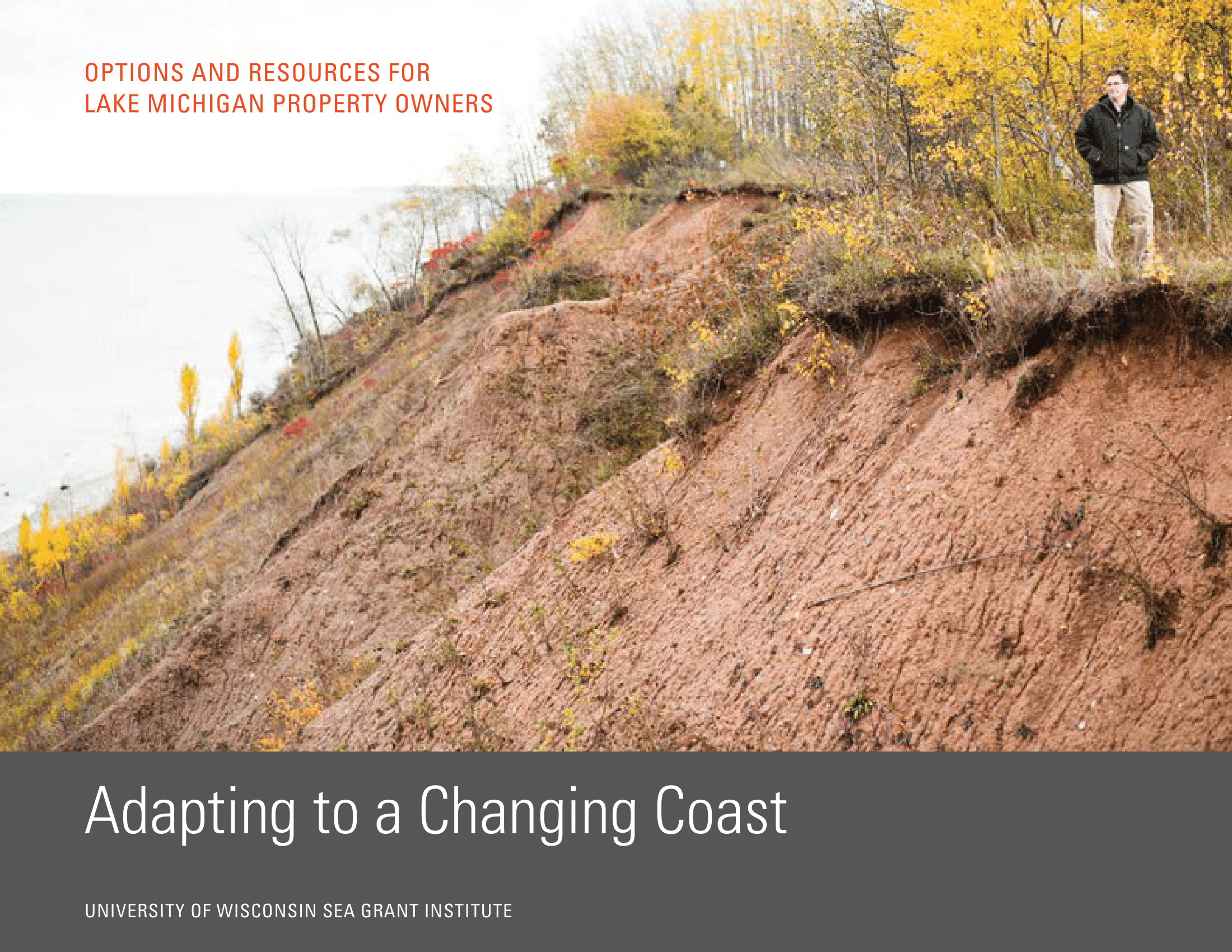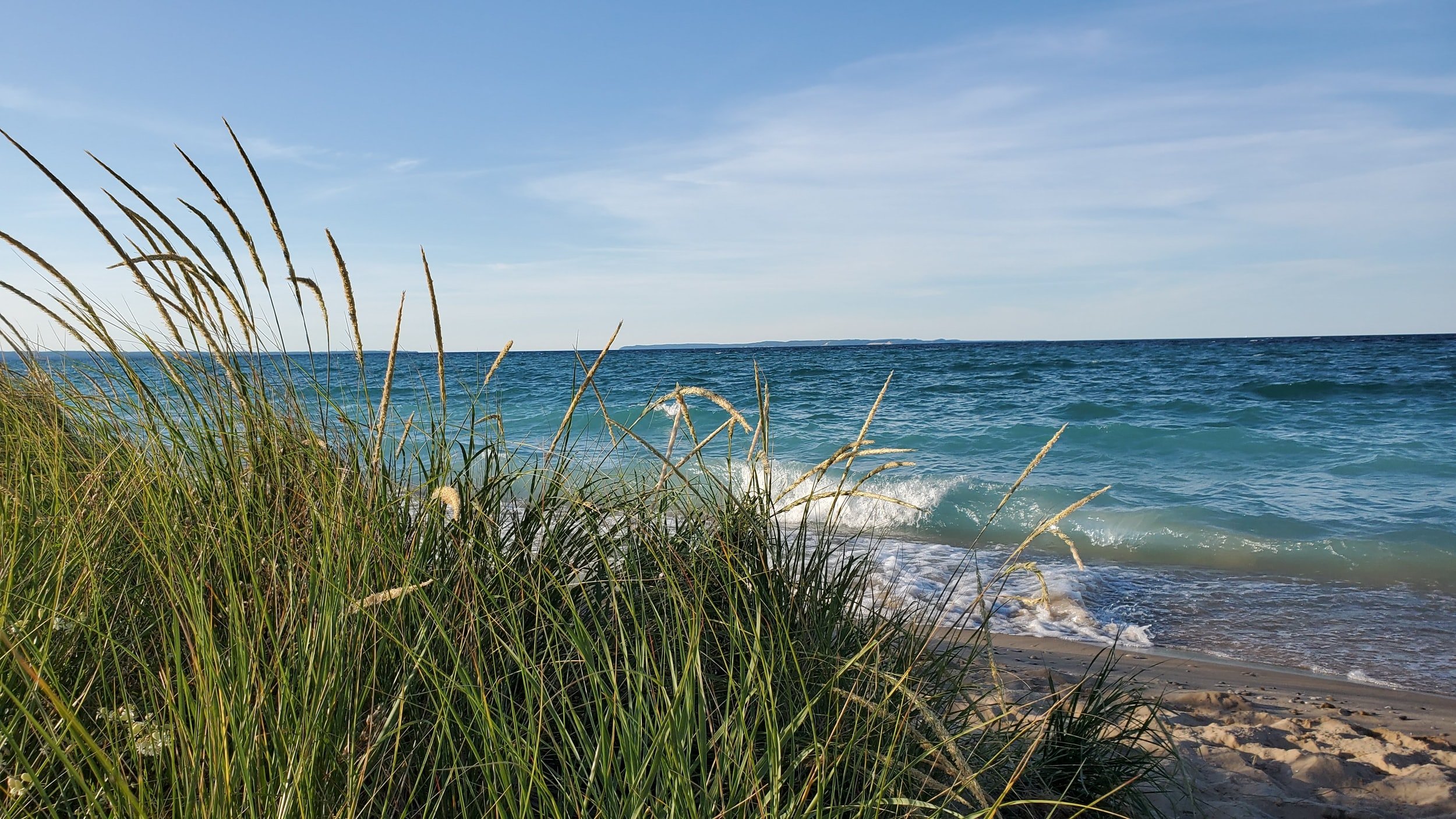-

Coastal Erosion Guides and Information
-

Managing Coastal Erosion with Native Plants
-

Native Plants Purchasing Guide
-

Coastal Erosion Management Methods
-

Local Shoreline Contractors
-
Household Permitting Information
-

Homeowner Flooding Preparation Information
Living on the Coast: Protecting Investments in Shore Property on the Great Lakes
Philip Keillor and Elizabeth White, editors. Co-published by the University of Wisconsin Sea Grant Institute and the U.S. Army Corps of Engineers-Detroit District
Living on the Coast informs readers on the natural process of coastal erosion while also providing information on how to restore, protect and maintain your coastal property. It goes over management practices and techniques you can use to protect your property along with covering the economics behind protecting your investments. It also provides a list of additional resources and a glossary with terms used in coastal engineering language.
Adapting to Changing Coasts for Property Owners
University of Wisconsin Sea Grant Institute
Adapting to a Changing Coast provides property owners with best practices to adapt and manage changing coastlines using various techniques that range from low-impact to high-impact. This resource also discusses how to form collaborations with neighboring property owners to help assist with managing coastlines.
-
-
-
-
Click Here (Map of Michigan)
This Website shows more targeted maps that display erosion risks organized by county and then township.
Click Here (High Risk Erosion by Township)
Managing Coastal Erosion with Native Plants
Why Native Plants?
Why Native Plants? - Wildflower Association of Michigan
Natural Shorelines for Inland Lakes - Michigan Sea Grant & MI DEQ
Planning Your Nearshore Garden
Planning natural shoreline landscapes on your inland lake - MSU Extension
Smart lake gardening - MSU Extension
Planning your Native Planting - Native Connections
Native Plant Erosion Control Plans and Illustrations
A Guide to Healthy Lakes Using Lakeshore Landscaping Pg. 14-29 - The Federation of Vermont Lakes and Ponds
Choosing Native Plants
Making your Native Plant Choices for Michigan’s Inland Lake Shorelines - MSU Extension
Smart waterfront plants to enhance your shoreline - MSU Extension
Groundcovers to Control Erosion - Michigan Gardener
Upper Peninsula Native Plant Guide - MSU Extension
Aquatic Plants
MI Invasive Aquatic Species List - Michigan.gov
Common Aquatic Plants of Michigan - MI EGLE
Aquatic Plan Management Information - Michigan.gov
Native Plants Purchasing Guide
Western U.P. Native Plant List for Erosion Control
Black-Eyed Susan - Rudbeckia hirta
Big Bluestem or Turkey Foot - Andropogon gerardii
Blue Flag Iris - Iris versicolor
Blue Vervain - Verbena hastata
Canada Anemone - Anemone canadensis
Cord Grass - Spartina pectinata
Little Bluestem - Schizachyrium scoparium
Spotted Joe-Pye weed - Eupatorium maculatum
Swamp Milkweed - Asclepias incarnata
Sweet Grass - Hierochloe odorata
Switch Grass - Panicum virgatum
Wild Bergamont - Monarda fistulosa
*Sources: MSU Extension & Michigan Gardener
Where to Purchase Native Plants
-
(906)-296-0920
-
-
https://www.hkconserve.com/tree-sale
The annual plant and tree sale begins in May and ends mid-April
-
“Wild Ones is a non-profit organization that promotes environmentally sound landscaping practices to preserve biodiversity through the preservation, restoration and establishment of native plant communities. Some of the ways Wild Ones strives to accomplish our mission is by providing educational resources and online learning opportunities”
Resources: Annual Plant Sale, where to buy native plants, native garden designs, planting instructions, recorded webinars
-
-
https://nativeconnections.net/native-seeds/
(269)-459-6900
Coastal Erosion Management Methods
-
-
-
-
Michigan Sea Grant hosted this webinar for all citizens, tribal and municipal officials, Great Lakes shoreline property owners, and other interested persons to explain wave dynamics and coastal engineering approaches. Topics include bank toe erosion and slope stability; the role of nature-based solutions where appropriate; what water levels/waves one should design for; ice issues; and benefits of collaborating with shoreline neighbors. Great Lakes coastal engineering practitioner Margaret Boshek leads this discussion.
Local Shoreline Contractors
-
(906) 523-3245
Nature-Based Shoreline Erosion Contractors in the UP
Services: Vegetation restoration and plantation services to retain, renourish and sustain beaches and natural lakefront properties. Construction of dunes, beach ridges, sand fencing, coir logs, and boulder walls.
-
(906)-369-3455
51811 Industrial Dr N, Calumet, MI 49913
Services: Silt Fence, inlet protection, ditch checks, turbidity barriers, dewatering filter bags
-
(906) 482-8965
54560 State Hwy M203 in Hancock, MI 49930
Services: Marine construction, shoreline construction, excavation and grading
Household Permitting Information
-
$50 Application Fee
For projects that would cause less than minimal impacts to water resources
Categories: Clear span bridge, construction and maintenance of a path on Great Lakes bottomland; culverts and bridges; culverts wetland equalizer; cutting and selective hand removal of invasive species; maintenance dredging; maintenance of stormwater management facilities; wetlands maintenance; moist soil management for wildlife; removal of structures; soil borings; spring piles and piling clusters; storm water management facilities.
-
$100 Application Fee
For projects that may need slightly more review than general projects
Categories: bioengineering practices for stabilization of inland lake shorelines; construction, maintenance and repair of berms and water control structures; diver-assisted hand removal of invasive species; dredging; driveway; fences; fills; fish and wildlife habitat structures; floodplain boardwalks, decks, stairs, and viewing platforms; maintenance or repairs of berms, dikes, and levees; outfall structures and associated intake structures; ponds; replacement of existing seawalls; residential construction for properties owned prior to 1980; reversion of temporary wetland enhancement, restoration and establishment; riprap shoreline protection; sandbags for temporary Great Lakes shoreline protection during high water; small dam removal; temporary construction, access, and dewatering; wetland habitat restoration and enhancement
-
Projects that do not fit into the general permit and minor project categories are considered “Individual Permits”
Categories: Seawalls, bulkheads, or revetments of 500 feet or more in length; filling or draining of 1 acre or more of contiguous coastal or inland wetland; new commercial docs or wharves of 300 feet or more in length; stream enclosures of 100 feet or more in length; stream relocations of 500 feet or more in length; shoreline projection that extends 150 feet or more into a lake or stream
Homeowner Home and Property Protection Guides
Homeowner’s Guide to Retrofitting - Six Ways to Protect Your Home From Flooding - FEMA
Protecting Your Home and Property From Flood Damage - FEMA
Protecting Building Utility Systems From Flood Damage - FEMA
Protecting Manufactured Homes from Floods and Other Hazards - FEMA
Reducing Flood Risk to Residential Buildings That Cannot Be Elevated- FEMA










